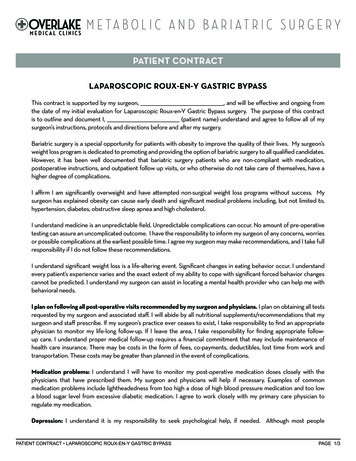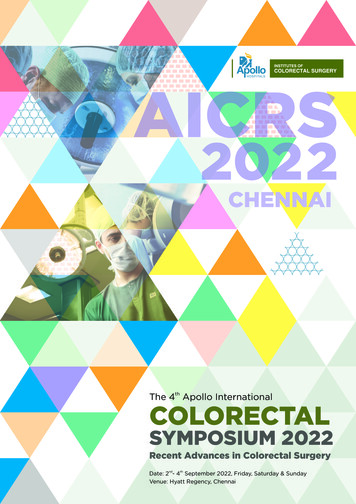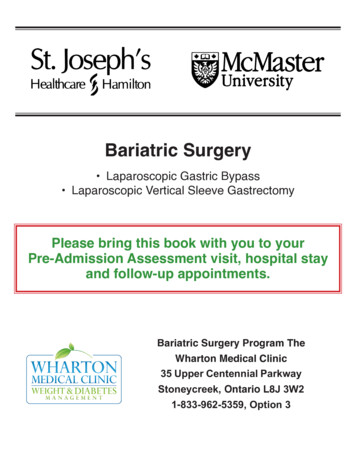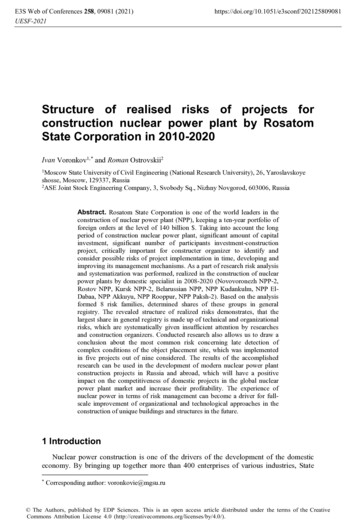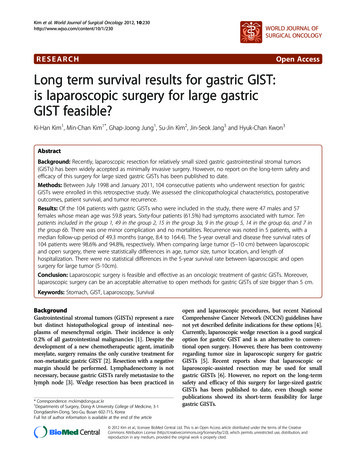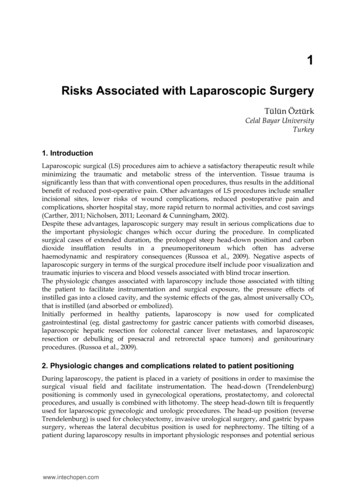
Transcription
1Risks Associated with Laparoscopic SurgeryTülün ÖztürkCelal Bayar UniversityTurkey1. IntroductionLaparoscopic surgical (LS) procedures aim to achieve a satisfactory therapeutic result whileminimizing the traumatic and metabolic stress of the intervention. Tissue trauma issignificantly less than that with conventional open procedures, thus results in the additionalbenefit of reduced post-operative pain. Other advantages of LS procedures include smallerincisional sites, lower risks of wound complications, reduced postoperative pain andcomplications, shorter hospital stay, more rapid return to normal activities, and cost savings(Carther, 2011; Nicholsen, 2011; Leonard & Cunningham, 2002).Despite these advantages, laparoscopic surgery may result in serious complications due tothe important physiologic changes which occur during the procedure. In complicatedsurgical cases of extended duration, the prolonged steep head-down position and carbondioxide insufflation results in a pneumoperitoneum which often has adversehaemodynamic and respiratory consequences (Russoa et al., 2009). Negative aspects oflaparoscopic surgery in terms of the surgical procedure itself include poor visualization andtraumatic injuries to viscera and blood vessels associated with blind trocar insertion.The physiologic changes associated with laparoscopy include those associated with tiltingthe patient to facilitate instrumentation and surgical exposure, the pressure effects ofinstilled gas into a closed cavity, and the systemic effects of the gas, almost universally CO2,that is instilled (and absorbed or embolized).Initially performed in healthy patients, laparoscopy is now used for complicatedgastrointestinal (eg. distal gastrectomy for gastric cancer patients with comorbid diseases,laparoscopic hepatic resection for colorectal cancer liver metastases, and laparoscopicresection or debulking of presacral and retrorectal space tumors) and genitourinaryprocedures. (Russoa et al., 2009).2. Physiologic changes and complications related to patient positioningDuring laparoscopy, the patient is placed in a variety of positions in order to maximise thesurgical visual field and facilitate instrumentation. The head-down (Trendelenburg)positioning is commonly used in gynecological operations, prostatectomy, and colorectalprocedures, and usually is combined with lithotomy. The steep head-down tilt is frequentlyused for laparoscopic gynecologic and urologic procedures. The head-up position (reverseTrendelenburg) is used for cholecystectomy, invasive urological surgery, and gastric bypasssurgery, whereas the lateral decubitus position is used for nephrectomy. The tilting of apatient during laparoscopy results in important physiologic responses and potential seriouswww.intechopen.com
2Advanced Laparoscopycomplications. During laparoscopy, it is difficult to clearly separate the effects of anesthesia,position, and pneumoperitoneum. Because abdominal insufflation adds to the deleteriousphysiologic effects of the head-down tilt position, special attention by the anesthesiologistmust be given to patients undergoing laparoscopic surgery in this position.2.1 Hemodynamic effects of positioning during laparoscopyIn a study of hemodynamic changes using transthoracic echocardiography in patientsundergoing gynaecological laparoscopic operations, the Trendelenburg position increasedcentral venous pressure (CVP), pulmonary capillary wedge pressure (PCWP) andpulmonary arterial pressures (PAP) and decreased cardiac output (CO) (Russo et al, 2009).Pneumoperitoneum increased these pressures further, mostly at the beginning of thelaparoscopy, and cardiac output decreased towards the end of the laparoscopy. In recentyears, gynaecological laparoscopic operations of longer duration with an even steeper headdown position are being performed.In the study by Meininger et al, ASA I-III patients undergoing total endoscopic radicalprostatectomy with 4 hours of pneumoperitoneum in the Trendelenburg positionexperienced no significant hemodynamic compromise. Placing the patient in theTrendelenburg position caused a significant increase in CVP (from 9.9 3.4 to 15.1 2.3 mmHg), whereas all other hemodynamic parameters [cardiac index (CI), heart rate (HR), meanarterial pressure (MAP), systemic vascular resistance index (SVRI), and intrathoracic bloodvolume] remained nearly unaffected, as measured with a continuous cardiac outputmonitoring (PiCCO) system via a femoral artery catheter (Meininger et al., 2008). Similarly,in the steep (40 ) Trendelenburg position during robotic prostatectomy, HR, MAP, CVP,oxygen saturation via pulse oximeter (SpO2), and end-tidal carbon dioxide (EtCO2)remained within a clinically acceptable range (Kalmar et al., 2010).The Trendelenburg position changes hemodynamic parameters and moves intraabdominalorgans cephalad due to gravity. The head-down position causes an increase in central bloodvolume in adult patients, with a resulting increase in cardiac output and systolic bloodpressure. However, an immediate systemic vasodilatation secondary to reflexbarostimulation also occurs, which leads to decreased stroke volume, reduced cardiacoutput, and diminished perfusion of vital organs. The physiology of a patient in thelithotomy position includes the physiologic consequences of leg elevation on central bloodvolume and a decrease in tissue perfusion in the elevated legs due to gravity. The lithotomyposition and pneumoperitoneum during laparoscopic surgery increase preload, probably asa result of blood shifting from the abdomen to the thorax by compression of splanchnicvessels caused by the pneumoperitoneum (Joris, 2005).The increased intra-abdominal pressure created in the head-up tilt position would be expectedto decrease venous return to the heart. In patients undergoing laparoscopic surgery in thehead-up tilt (15-20 ) position, as measured with a pulmonary artery catheter, HR, CI, strokeindex (SI), CVP, and PCWP decreased, systemic vascular resistance increased, and MAP didnot change (Hirvonen et al., 2000). Likewise, Alishlai et al., (2000) found that both cardiacoutput and stroke volume fell, whereas HR, systolic BP, and diastolic BP did not change inASA I-III patients undergoing laparoscopic surgery (cholecystectomy, fundoplication, liverthermal ablation) during pneumoperitoneum in the 30 head-up tilt position.The lateral decubitus position has minimal effects on major organ function when the patientis carefully positioned. In the elderly, hypovolemic, and hypertensive patients, bloodwww.intechopen.com
Risks Associated with Laparoscopic Surgery3pressure may not remain stable. The right lateral decubitus position appears to have greaterpropensity for caval compression and reduced venous return because of the closerproximity of the vena cava to the right flank. In the lateral flexed position, venous returnmay fall significantly, resulting in low cardiac output and hypotension. The physiologicaleffects of positioning on cardiorespiratory function, particularly in elderly patients with comorbidities (obesity, COPD, hypertension, coronary artery disease, etc.) may be catastrophic(Gottumukkala et al., 2008).Cardiovascular Decreased left ventricular function Decreased cardiac output Decreased mean arterial pressure Increased systemic vascular resistance Increased central venous pressure Increased pulmonary artery pressure Increased pulmonary capillary wedge pressureRespiratory Reduced vital capacity Decreased respiratory plateau pressure Decreased compliance HypoxemiaCentral nervous system Increased intracranial pressure Decreased cerebral perfusion pressureTable 1. Physiologic changes due to Trendelenburg positioning2.2 Respiratory and ventilatory effects of positioningThe steep head-down position in an anesthetized patient results in atelectasis andsometimes hypoxemia due to decreased functional residual capacity (FRC). Withinduction of anesthesia, the increased central blood volume, cephalad displacement of thediaphragm, and the weight of the abdominal contents impeding diaphragmatic excursionreduces pulmonary vital capacity. As a result of these changes, impedance of the chestwall and lung increases, an effect which is more pronounced in elderly and obesepatients. Inhibition of lung expansion can occur, as well as right mainstem bronchialintubation, both of which are possible causes of hypoxemia in patients placed in the steephead-down position (Kalmar et al., 2010).During laparoscopy in the Trendelenburg lithotomy position, compared with youngpatients, elderly patients had an higher P(a-ET)CO2 in the setting of mechanical ventilationbased on the value of EtCO2. PaCO2 increased progressively in both groups. Increasing thetidal volume to keep PETCO2 within 20% of the pre-insufflation value may not prevent theincrease in P(a-ET)CO2; thus all patients, especially elderly ones, should be followed withcaution while in the Trendelenburg lithotomy position (Takahata et al., 2007). Overweightpatients (BMI of 25–29.9 kg/m2) who underwent totally endoscopic robot-assisted radicalprostatectomy under general anesthesia in Trendelenburg position had a significantly lowerPaO2 and higher the alveolar–arterial PO2 difference compared with normal weight patients(Meininger et al., 2006). Similarly, SpO2, EtCO2, tidal volume, compliance, and minutewww.intechopen.com
4Advanced Laparoscopyventilation remained within a clinically acceptable range in normal weight patients withsteep (40 ) Trendelenburg positioning during robotic prostatectomy (Kalmar et al., 2010).2.3 Cerebral effects of positioningTrendelenburg positioning causes an increase in intracranial pressure (ICP) due to increasedvenous pressure, which hinders cerebral venous drainage with a consequential increase inthe cerebral blood volume (Mavrocordatos et al., 2000). Only a limited number of studiesfocus on the relationship between Trendelenburg positioning and regional cerebral oxygensaturation (rSO2). Harrison et al (Harrison et al., 2001) found no difference in rSO2 whencomparing values at the beginning and end of abdominal surgery performed with patientsin the Trendelenburg position.Regional cerebral oxygen saturation did not change in patients undergoing robot-assistedlaparoscopic radical prostatectomy in a 30 Trendelenburg position (Park et al., 2009).However, in a study of gynaecologic laparoscopic surgery patients (Lee et al., 2006), themean rSO2 was found to fall from 65.5 5.4% (baseline before surgery) to 60.8 5.6% when thepatients were initially placed in the Trendelenburg position.2.4 Patient position and lower extremity hypoperfusionWhile in the lithotomy position, particularly when a head-down position is used, generalhypoperfusion of the lower extremities may be exacerbated. Lithotomy positions (low,standard, high, and exaggerated) differ primarily from one another by the degree of hipangulation and height of leg placement. The hydrostatic gradient of arterial blood pressurebetween the ankle and the heart in these positions may decrease lower extremity bloodpressure and contribute to lower extremity hypoperfusion. Lower-extremity systolicpressures may be reduced significantly in some patients, so much so that the lowerextremities may be at risk for ischemia (Halliwill et al., 1998). Prolonged ischemia duringsurgical procedures performed on patients in lithotomy positions probably increases the riskof compartment syndrome. Long operation time (466 min), obesity (body mass index (BMI)29.0 kg/m2), and hypothermia during the operation (body temperature 34.2 C) also seemedto be risk factors that could have contributed to the symptoms observed in a case oflithotomy position-related compartment syndrome (Ikeya et al., 2006). To minimize the riskof compartment syndrome, surgeons should perform appropriate positioning andrepositioning during surgery.3. Pneumoperitoneum during laparoscopy3.1 Hemodynamic changes due to pneumoperitoneumPneumoperitoneum is associated with altered cardiac and pulmonary physiology whichmay cause significant complications. The hemodynamic changes due to position are mostsignificant at the initiation of pneumoperitoneum and near the end of the laparoscopicsurgery. The adverse effects of pneumoperitoneum on cardiac performance are due todecreased venous return (cardiac preload), increased systemic vascular resistance(afterload), or both. (Alishlai et al., 2001).The hemodynamic changes associated with pneumoperitoneum depend on a number offactors, including the mean intraabdominal pressure, amount of CO2 absorbed, thepatient’s level of hydration, the type of ventilation, and the nature of the surgery.Investigators have found significant interpatient variability regarding the reduction ofwww.intechopen.com
Risks Associated with Laparoscopic Surgery5cardiac output and stroke volume associated with pnuemoperitoneum (Alishlai, 2001;Haxby, 1994). These differences could be at least be partially due to varying postures,arterial CO2 partial pressures, anesthetic techniques, measurement techniques, andintraoperative fluid regimens.A variety of patients undergo laparoscopic cholecystectomy, hernia repair, urogenitalsurgery, and cancer surgery, ranging from young healthy patients to older patients withcardiopulmonary disease. Morbidly obese patients who undergo gastric bypass surgeryoften have significant comorbid conditions such as coronary artery disease, diabetesmellitus, cerebral vascular disease, restrictive lung disease, sleep apnea, and hypertension.Invasive hemodynamic monitoring may benefit high-risk patients undergoing laparoscopicsurgery (Hironen, 2000; Koivusalo, 2008). Extending the scope of laparoscopic techniques toolder patients at higher risk of cardiovascular complications requires reappraisal ofhemodynamic monitoring during anaesthesia.During laparoscopy, to evaluate cardiac function, most investigators have used pulmonaryartery catheterization which is both invasive and not routine in clinical practice (Hironen etal., 2000). Usually, invasive haemodynamic monitoring is used only in patients undergoinglaparoscopic surgery who have pre-existing cardiovascular disease (Artuso, 2005;Koivusalo, 2008). This technique permits more precise calculation of left ventricular preload,afterload, and oxygen delivery. However, these advantages must be weighed against a lowbut appreciable risk of morbidity, which may not be acceptable in many patients.Noninvasive monitoring of patients at risk for acute hemodynamic changes that may not bereadily revealed by conventional intraoperative monitoring techniques is oftenrecommended, usually transoesophageal echocardiography (Alishahi, 2001; Fahy, 1999;Haxby, 1997; Russoa, 2009; Rist, 2001 ).Haxby et al (Haxby et al., 1997) measured aortic flow velocity using oesephageal Dopplerbefore, during, and after induction of carbon dioxide pneumoperitoneum in head-downposition patients undergoing laparoscopic hernia repair. They found that the insufflation ofthe abdomen with the carbon dioxide (at 13 mmHg; a relatively low intraabdominalpressure) produced significant effects on the cardiovascular system, but the clinicalsignificance of these changes was uncertain. Likewise, during laparoscopic surgery of thelower abdomen in the head-up tilt position CO was found to fall after abdominalinsufflation (peak intra-abdominal pressure: 13-15 mmHg). The CO fell more (30%) inpatients with high surgical risk than in patients with low risk (25%), when patients wereclassified according to ASA physical status classification (Rist et al., 2001).Patients in the head-down tilt position during laparoscopic hysterectomy were found to have asignificant reduction in stroke volume, cardiac output and left ventricular end-diastolicvolume and increase in afterload with pneumopericardium, as measured with cardiac apicalDoppler echocardiography. The augmented preload resulted in an increase in stroke volume,cardiac output and left ventricular end-diastolic volume in both laparoscopic hysterectomyand conventional open hysterectomy groups. Branche et al (Branche et al., 1998) investigatedthe effect of intraperitoneal insufflation of carbon dioxide and head up (10 ) tilt position on leftventricular afterload by using transaesophageal echocardiography in patients undergoinglaparoscopic cholecystectomy. They found that systolic arterial pressure increased at thebeginning of the pneumoperitoneum and subsequently decreased gradually duringpneumoperitoneum. Significant variation in HR and regional wall motion were not observed,but left ventricular afterload and left ventricular end-systolic wall stress increased.www.intechopen.com
6Advanced LaparoscopyIn morbidly obese laparoscopic gastric bypass surgery patients (Artuso et al., 2005), uponinsufflation of the abdomen, systemic blood pressure, pulmonary artery pressure, centralvenous pressure, and pulmonary artery capillary wedge pressure increased significantlyfrom baseline values, but CI and SVR did not change significantly. These changes wereattenuated when the patient was placed in the reverse Trendelenburg position and almostcompletely corrected when the abdomen was deflated at the completion of the procedure.Laparoscopic gastric bypass surgery candidates who often have significantcardiorespiratory comorbidities, like other high-risk patients undergoing laparoscopicsurgery, may benefit from invasive hemodynamic monitoring. Likewise, the head-upposition in patients undergoing laparoscopic cholecystectomy, SI decreased, but CI did notchange significantly because of the compensatory increase in heart rate (Hirvonen etal., 2000). CO2 insufflation at the start of laparoscopy increased CVP and PCWP as well asmean systemic and mean pulmonary arterial pressures without significantly changing CI orSI. Toward the end of the laparoscopy, CI decreased by 15%. The hemodynamic valuesreturned to nearly pre-laparoscopic levels after deflation of the gas, and CI increased duringthe recovery period, whereas systemic vascular resistance was 15% lower in the recoveryroom compared to preinsufflation values.Laparoscopy in the lateral flexed position may significantly decrease venous return, causinglow cardiac output and hypotension. This condition can be prevented by fluid loading andpromptly reversed by deflation and table deflection.Fahy et al, (Fahy et al., 1999) detected a high incidence of regurgitation in healthy donors inthe lateral decubitus position at the mitral, tricuspid, pulmonic, and aortic valves with transoesephageal echocardiogram (TEE) after CO2 insufflation during laparoscopic nephrectomy.The consequences of these challenges in patients with preexisting valvular or cardiac diseasewould be more serious. Patients with cardiovascular disease have responses to laparoscopythat are affected by the extent of cardiac reserve, baseline medications, level of hydration,and their response to the anesthesia medications used (Slodzinski & Merritt, 2008).For abdominal laparoscopic procedures, IAP is usually not allowed to exceed 15 mm Hg,but during pelvic procedures a higher IAP (approximately 25 mm Hg) is used. An IAP ofless than 15 mm Hg is required during laparoscopic cholecystectomy, in so far as it reducesthe risks associated with high pressures (Catani et al., 2004). Cardiovascular variablesusually return to preinsufflation values after a pneumoperitoneum of short duration.When a pneumoperitoneum is created for laparoscopic surgery in patients with no knowncardiac disease, a decrease in left ventricular function and CO, and an increase in CVP (fromredistribution of abdominal blood volume), systemic vascular resistance, and mean arterialpressure occurs, as measured by noninvasive methods (Critchley, 1993; Girardis, 1996;Westerband, 1992), thermodilution catheter (Hirvonen et al, 2000), transoesophagealechocardiography (Gannedahl, 1996; Harris, 1996; Haxby, 1997; Rist, 2001), andtransthoracic echocardiography (Russoa et al., 2009).Cases of sudden intraoperative cardiovascular collapse or severe pulmonary edemarequiring ventilation after uneventful laparoscopic cholecystectomy have been reported(Giaquinto et al., 2003). The adverse effects on cardiac performance produced bypneumoperitoneum may increase the risk of cardiac complications in patients withunderlying cardiac and pulmonary disease. In addition to the central changes,pneumoperitoneum results in reduced peripheral venous flow (Alishahi, 2001; Schwenk,1998) and diminished perfusion of intraabdominal organs (Jakimowicz et al., 1998).Blood flow falls significantly in the renal, hepatic, gastric, and mesenteric beds duringlaparoscopic surgery with pneumoperitoneum (Ishizaki et al., 1993; Jakimowicz et al., 1998);www.intechopen.com
Risks Associated with Laparoscopic Surgery7resulting in impaired renal function in some patients. In nephrectomy patients withpreexisting renal disease, laparoscopy may create additional kidney injury as a result ofelevated intraabdominal pressure and kidney manipulation (Crane et al., 2008). In patientsundergoing laparoscopic surgery (cholecystectomy, fundoplication, liver thermal ablation)in the reverse Trendelenburg position, common femoral venous flow falls significantly. Theapplication of intermittent sequential pneumatic compression (ISPC) of the lower limbsduring laparoscopic surgery reversed that effect, returning peak systolic velocity to normal(Millard, 1993; Alishahiet, 2001).3.2 Respiratory and ventilatory effects of pneumoperitonium during laparoscopyThe changes with pneumoperitoneum in the mechanical properties of the respiratorysystem are related to two main factors: shifting of blood flow to the pulmonary circulationand compression of the lung bases by raising the dome of the diaphragm. Increasedpressure within the abdomen increases the intrathoracic pressure by pushing thediaphragm upward, thus decreasing respiratory system compliance, which in turn resultsin reduced lung volumes and increased airway pressures (Hirvonen, 1995; Odeberg,1994). These changes predispose patients to airway closure and collapse of dependentlung regions (atelectasis) (Andersson, 2005; El-Dawlatly, 2005; Nguyen, 2005). Atelectasiscan be prevented by positive end-expiratory pressure or treated by inflation maneuvers(Strang et al., 2009).Obese patients have a greater risk of atelectasis than non-obese patients. Preventingatelectasis is important for all patients, but is especially important when caring for obesepatients.The use of high positive end-expiratory pressure (10 cm H2O) in patients undergolaparoscopic bariatric surgery resulted in improved respiratory function and oxygenation inobese patients (Talab et al., 2009). When compared to preinsufflation values, abdominalinsufflation to 2.26 kPa caused a significant (31%) decrease in respiratory systemcompliance, a significant (17%) increase in peak and plateau (32%) airway pressures atconstant tidal volume with significant hypercapnia, but no change in arterial O2 saturationin obese patients undergoing laparoscopic gastroplasty. Respiratory system compliance andpulmonary insufflation pressures returned to baseline values after abdominal deflation(Dumont et al., 1997).Positive end expiratory pressure (PEEP) prevents the upward shift of the diaphragm duringlaparoscopy, limits the deliterious effects of surgery on respiratory mechanics, and improvesoxygenation. However, no consensus has been reached regarding the ideal level of PEEPduring laparoscopic surgery. A PEEP of 10 cm H2O had better oxygenation bothintraoperatively and postoperatively in the PACU, lower atelectasis score on chestcomputed tomographic scan, and less postoperative pulmonary complications than a PEEPof 0 cm H2O (ZEEP) and 5 cm H2O in patients undergo undergo laparoscopic bariatricsurgery (Talab et al., 2009.) Likewise, a PEEP of 10 cm H2O produced beneficial effects in theelasticity, as well as in the resistance, of the respiratory system in patients undergoingcholecystectomy video-laparoscopy procedures (Maracaja-Neto et al., 2009).The use of a recruitment maneuver (RM) re-expanded atelectasis and improved oxygenationin obese patients undergoing laparoscopic procedures (Almarakbi, 2009; Chalhoub, 2007;Whalen, 2006). RMs and PEEP were both required to prevent rapid reoccurrence ofatelectasis, especially when a high-inspired oxygen fraction was used. Oxygenation may bea poor indicator of the extent of lung collapse as oxygenation has not been found to correlatewith atelectasis formation during pneumoperitoneum (Andersson, 2005; Strang, 2009).www.intechopen.com
8Advanced LaparoscopyEnd-expiratory lung volumes are commonly used in clinical practice to denote functionalresidual capacity during mechanical ventilation. Futierae et al (Futierae et al., 2010)investigated the effects of RM after application of PEEP on changes in end expiratory lungvolume (EELV), respiratory mechanics, and oxygenation in healthy weight and obesepatients undergoing laparoscopic surgery. They found that pneumoperitoneum worsenedthe reduction in EELV and respiratory mechanics produced by anesthesia induction, withno major effect on oxygenation. A PEEP of 10 cm H2O combined with RM inducedsustained improvements in EELV, gas exchange, and respiratory mechanics, and may beuseful in counteracting the detrimental effects of pneumoperitoneum, especially on lungvolume reduction in healthy weight and obese patients (Futier et al., 2010). Bothconventional volume-controlled ventilation and pressure-controlled ventilation (PCV)were found to be equally suited for patients undergoing laparoscopic gynaecologicsurgery. However, a higher lung compliance and lower peak airway pressures, plateaupressures, and airway resistance were observed with PCV in laparoscopic gynaecologicsurgery patients (Oğurlu et al., 2010).Patients with pulmonary dysfunction are at high risk for complications; pre-op screeningwith pulmonary function tests is of the utmost importance for these patients. In morbidlyobese patients, compared with open gastric bypass procedure (GBP), laparoscopic gastricbypass resulted in higher EtCO2, peak inspiratory pressure, total exhaled CO2 per minute,and a lower respiratory compliance. Arterial blood gas analysis demonstrated higher PaCO2and lower pH during laparoscopic GBP than during open. Laparoscopic GBP altersintraoperative pulmonary mechanics and acid-base balance but does not significantly affectpulmonary oxygen exchange. Changes in pulmonary mechanics are well tolerated inmorbidly obese patients when proper ventilator adjustments are maintained (Nguyen et al.,2004). Sprung et al (Sprung et al., 2003) showed that arterial oxygenation duringlaparoscopy could not be improved by increasing either the tidal volume or respiratory rate.In morbidly obese patients with chronic obstructive pulmonary disease and hypertension,the 20 reverse Trendelenburg position during laparoscopic gastric banding surgeryimproved respiratory mechanics (respiratory compliance, airway resistance and peakinspiratory pressure) and oxygenation without any apparent adverse effects onhaemodynamics (Salihoglu et al., 2003). On the other hand, PaO2 was significantly lowerand the alveolar-arterial oxygen difference (A-aDO2) was higher in overweight (BMI 25–29.9kg/m2) and normal weight (BMI 18.5–24.9 kg/m2) patients who underwent totallyendoscopic robot-assisted radical prostatectomy in the Trendelenburg position (Meiningeret al., 2006). Whereas pneumoperitoneum did not have any significant effect in normalweight patients, A-aDO2 decreased to below baselines values in overweight patients afterprolonged (1.5 hours) pneumoperitoneum.The kidney position can lower the vital capacity by another 5–10%. Most of this decrease isthought to result from reduced movement of the ribs and diaphragm. Although vital capacityand FRC are reduced in the lateral decubitus position, better ventilation–perfusion matchingresults from increased perfusion in the dependent lung and corresponding increase inventilation from the stretched dependent hemidiaphragm. However, general anesthesia in thelateral decubitus position causes an increased mismatch in ventilation–perfusion ratioscompared to that in awake subjects. Complications from the lateral decubitus position includepressure injuries (ischemic), muscular and ligamentous strain, whiplash-like injury to thecervical spine, neurologic injuries, and ocular complications (corneal abrasions, pressureeffects, dependent edema, and blindness) (Gottumukkala, 2008).www.intechopen.com
Risks Associated with Laparoscopic Surgery93.3 Hypercarbia-induced pneumoperitoniumLaparoscopic procedures use carbon dioxide, a highly diffusable gas, for insufflation. CO2insufflated during laparoscopy is soluble in blood, and after transperitoneal absorption ispresented to the lungs for excretion. The high solubility of CO2 in the blood streamminimizes the risk of gas emboli. ETCO2 increases from 0–30% when minute ventilation isheld constant, but increasing respiratory rate, tidal volume, or both by as much as 30% maybe necessary to keep the ETCO2 in the mid-30s (mm Hg) range. This almost always meansgeneral anesthesia with endotracheal intubation to maintain adequate ventilation, whichtends to be impaired by surgical positioning and abdominal distension. Higherintraabdominal pressures are associated with faster CO2 absorption and gas embolism.These effects are further influenced by the intraoperative position of the patient andduration of procedure, and whether the patients have pre-existing cardiovascular disease.(Slodzinski & Merritt, 2008).Patients with preoperative cardiopulmonary disease demonstrated significantly higher PaCO2 levels and lower pH during carbon dioxide insufflation compared to patients withoutunderlying disease. During laparoscopic cholecystectomy, patients with chroniccardiopulmonary disease may require careful intraoperative arterial blood gas monitoring ofabsorbed carbon dio
minimizing the traumatic and metabolic stress of the intervention. Tissue trauma is significantly less than that with conventional open procedures, thus results in the additional benefit of reduced post-operative pain. Other advantages of LS procedures include smaller . (ICP) due to increased venous pressure, which hinders cerebral venous .



